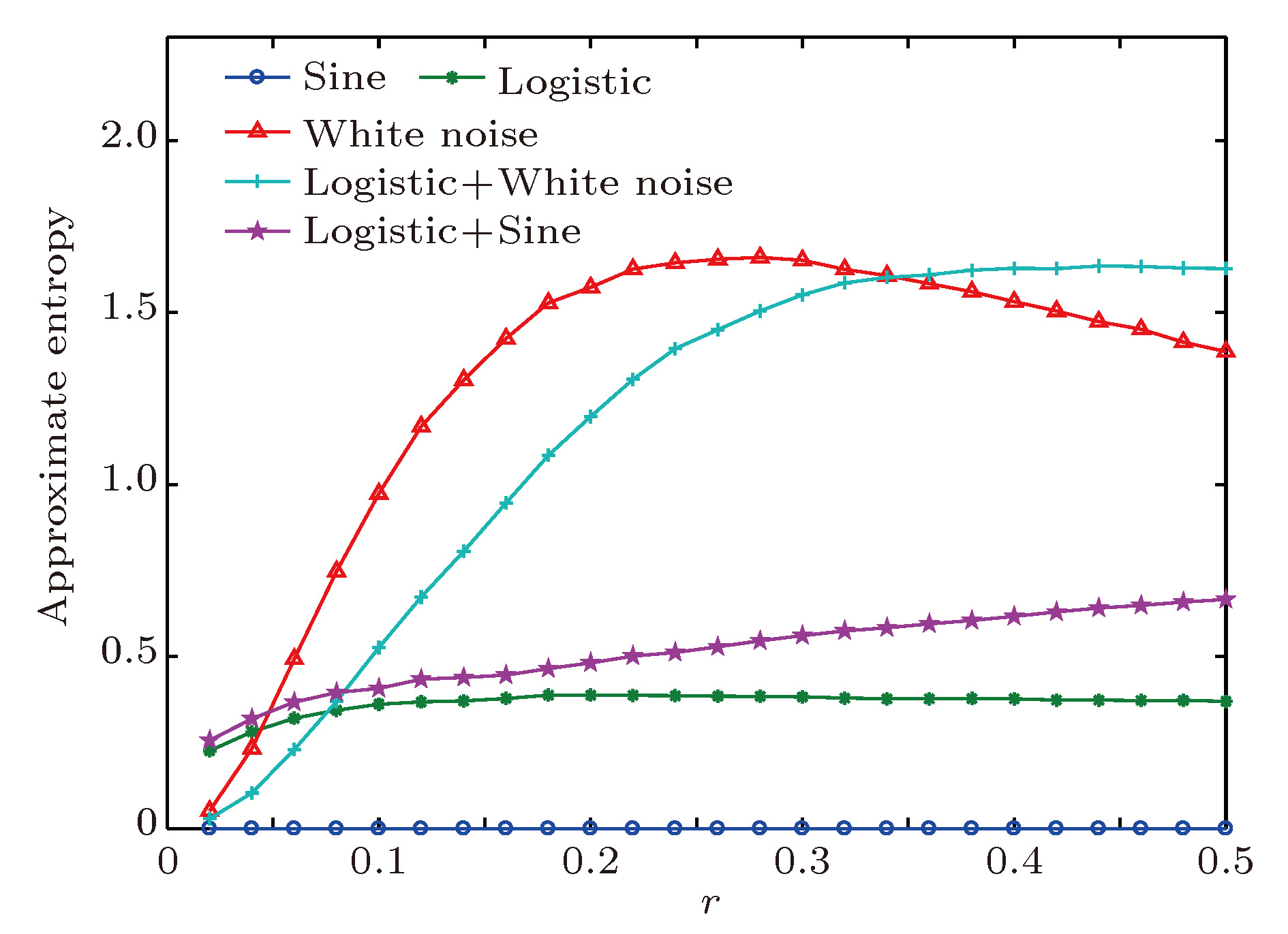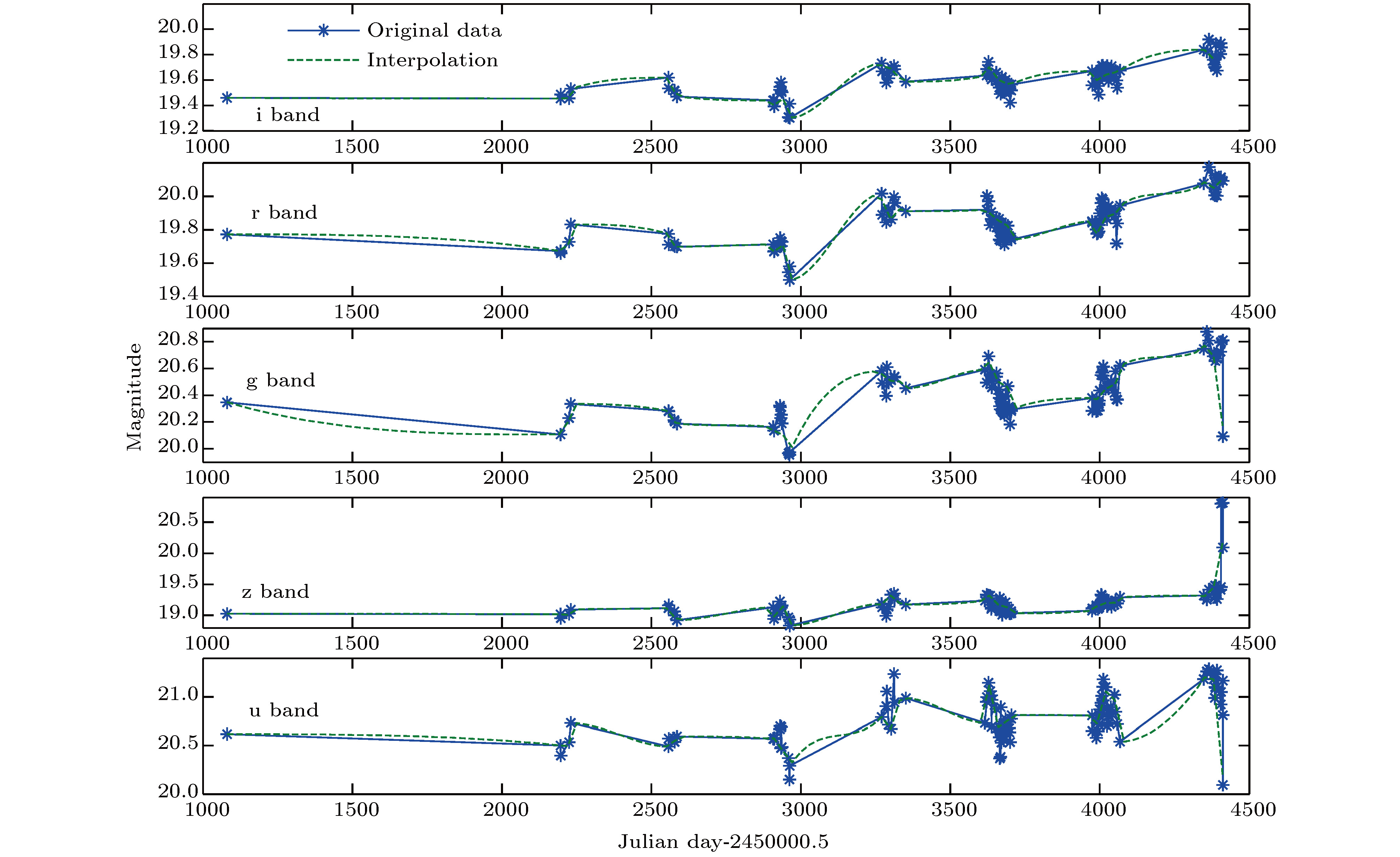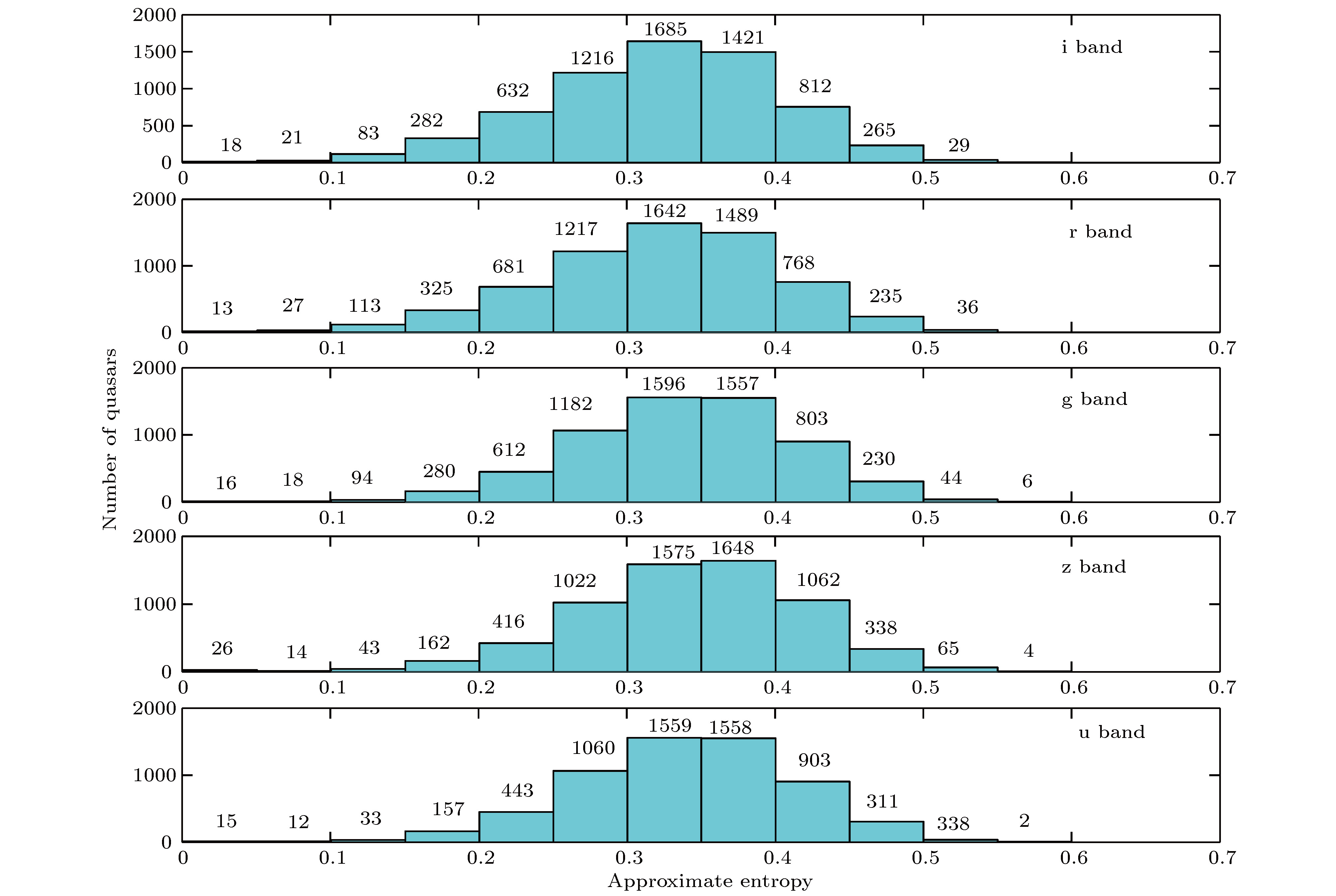-
光变是类星体的重要观测特征之一, 类星体在多个波段存在剧烈的光变现象. 光变非常复杂, 具有非线性特征. 以斯隆数字化巡天(Sloan digital sky survey, SDSS) stripe 82天区中的类星体为研究对象, 利用近似熵方法分析了类星体光变的复杂性. 首先应用模拟信号检验了近似熵方法对周期序列、白噪声序列、混沌序列和组合序列的区分能力, 验证了近似熵方法是一种识别不同类型时间序列的有效方法. 再计算了SDSS第7次释放数据中光谱证认过的类星体光变的近似熵, 并分析了它们的复杂性. 结果表明: SDSS类星体光变的近似熵值最大值为0.58, 类星体光变的复杂性介于周期序列和白噪声序列的复杂性之间, 近一半样本的复杂性与混沌序列基本一致.Variability is one of the most important observational features of quasars, and it is still not clear that the different quasars show different characteristic variability patterns. The optical variability of quasar is very complex, and optical variability has the non-linear characteristic of complex system. In this paper, the approximate entropy method is employed to analyze the complexities of variability in the Sloan digital sky survey (SDSS) stripe 82 quasars. Firstly, in order to show that the approximate entropy method has the effective ability to distinguish the different types of time sequences, the approximate entropy of periodic sequence, noise sequence, chaotic sequence and their mixed sequences are calculated by using the analog signals. The approximate entropy method proves to be an effective method to identify different types of time sequences. Then, we present the approximate entropy of optical variability of spectroscopically-confirmed quasars from the SDSS data release 7 spectroscopic catalog, and their complexities are analyzed. The results show that the maximum approximate entropy of quasars’ optical variability is only 0.58. The complexity of quasars’ optical variability is between the complexities of periodic sequence and white noise sequence. For nearly half of the samples, the complexities of their optical variability are basically consistent with the complexity of chaotic sequence. Quasars’ optical variability is neither completely periodic nor completely stochastic.
-
Keywords:
- quasars /
- variability /
- approximate entropy /
- complexity
[1] Fan J H, Zhang Y W, Qian B C, Tao J, Liu Y, Hua T X 2009 Astrophys. J. Suppl. Ser. 181 466
 Google Scholar
Google Scholar
[2] 黄克谅 2005 类星体与活动星系核 (北京: 科学出版社) 第3页
Huang K L 2005 Quasars and Active Galactic Nucleus (Beijing: Science Press) p3 (in Chinese)
[3] Kawaguchi T, Mineshige S, Umemura M 2002 Astrophys. J. 504 671
[4] MacLeod C L, ŽIvezić C S, Kochanek S, Kozłowski B, Kelly E, Bullock A, Kimball B, Sesar D, Westman K B 2010 Astrophys. J. 721 1014
 Google Scholar
Google Scholar
[5] Kasliwal P V, Vogeley S M, Richards T G 2015 Mon. Not. R. Astron. Soc. 451 4328
 Google Scholar
Google Scholar
[6] Guo H X, Wang J X, Cai Z Y, Sun M Y 2017 Astrophys. J. 847 132
 Google Scholar
Google Scholar
[7] Harko T, Leung C S, Mocanu G 2014 European Physical Journal C 74 2900
 Google Scholar
Google Scholar
[8] Charisi M, Bartos I, Haiman Z, Price-Whelan A M, Márka S 2015 Mon. Not. R. Astron. Soc. 45 4
[9] D'Orazio D J, Haiman Z, Schiminovich D 2015 Nature 525 351
 Google Scholar
Google Scholar
[10] Bhatta G, Zola S, Stawarz Ł, Ostrowski M, Winiarski M, Ogłoza W, Dróżdż M, Siwak M, Liakos A, et al 2016 Astrophys. J. 832 47
 Google Scholar
Google Scholar
[11] Carrasco L, Dultzinhacyan D, Cruzgonzalez I 1985 Nature 314 146
 Google Scholar
Google Scholar
[12] Kidger M, Takalo L, Sillanpää A 1992 Astron. Asrtophys. 264 32
[13] Valtonen M J, Lehto H J, Sillanpää A, Nilsson K, Mikkola S, Hudec R, Basta M, Teräsranta H, Haque S, Rampadarath H 2006 Astrophys. J. 646 34
[14] Misra R, Harikrishnan K P, Ambika G, Kembhavia A K 2006 Advances in Space Research 643 1114
[15] Harikrishnan K P, Misra R, Ambika G 2011 Research in Astron. Astrophys. 11 71
 Google Scholar
Google Scholar
[16] Emmanoulopoulos D 2007 Ph. D. Dissertation (Heidelber: Ruperto-Carola University of Heidelberg)
[17] 唐洁 2014 物理学报 63 049701
 Google Scholar
Google Scholar
Tang J 2014 Acta. Phys. Sin. 63 049701
 Google Scholar
Google Scholar
[18] 郝柏林 2001 物理 30 466
 Google Scholar
Google Scholar
Hao B L 2001 Physics 30 466
 Google Scholar
Google Scholar
[19] Pincus S M, Huang W M 1992 Commun. Statist-Theory Meth. 21 3061
 Google Scholar
Google Scholar
[20] 金宁德, 董芳, 赵舒 2007 物理学报 56 0720
Jin N D, Dong F, Zhao S 2007 Acta. Phys. Sin. 56 0720
[21] Lempel A, Ziv J 1976 IEEE Trans. on Inf. Theory 22 75
 Google Scholar
Google Scholar
[22] 郭家梁, 钟宁, 马小萌, 张明辉, 周海燕 2016 物理学报 65 190501
 Google Scholar
Google Scholar
Guo J L, Zhong N, Ma X M, Zhang M H, Zhou H Y 2016 Acta. Phys. Sin. 65 190501
 Google Scholar
Google Scholar
[23] Pettitt A N, Stephens M A 1977 Technometrics 19 205
 Google Scholar
Google Scholar
[24] Hughes P A, Aller H D, Aller M F 1992 Astrophys. J. 396 469
 Google Scholar
Google Scholar
[25] Scargle J D 1982 Astrophys. J. 263 835
 Google Scholar
Google Scholar
[26] 唐洁, 刘晓琴, 傅明星 2018 陕西理工大学学报(自然科学版) 33 87
 Google Scholar
Google Scholar
Tang J, Liu X Q, Fu M X 2018 Journal of Shaanxi University of Technology (Natural Science Edition)
33 87  Google Scholar
Google Scholar
-
表 1 SDSS类星体的近似熵
Table 1. Approximate entropy of SDSS quasars
近似熵值 0—0.1 0.1—0.2 0.2—0.3 0.3—0.4 0.4—0.5 0.5—0.6 波段 总样本数 样本数 百分数/% 样本数 百分数/% 样本数 百分数/% 样本数 百分数/% 样本数 百分数/% 样本数 百分数/% i 6465 39 0.60 365 5.65 1848 28.58 3106 48.04 1077 16.66 30 0.47 r 6547 40 0. 61 438 6.69 1898 28.99 3131 47.82 1003 15.32 37 0.57 g 6439 34 0.53 374 5.81 1794 27.86 3153 48.97 1033 16.04 51 0.79 z 6373 40 0.63 203 3.19 1438 22.56 3223 50.57 1400 21.97 69 1.08 u 6092 27 0.44 190 3.12 1503 24.67 3117 51.17 1214 19.93 41 0.67 -
[1] Fan J H, Zhang Y W, Qian B C, Tao J, Liu Y, Hua T X 2009 Astrophys. J. Suppl. Ser. 181 466
 Google Scholar
Google Scholar
[2] 黄克谅 2005 类星体与活动星系核 (北京: 科学出版社) 第3页
Huang K L 2005 Quasars and Active Galactic Nucleus (Beijing: Science Press) p3 (in Chinese)
[3] Kawaguchi T, Mineshige S, Umemura M 2002 Astrophys. J. 504 671
[4] MacLeod C L, ŽIvezić C S, Kochanek S, Kozłowski B, Kelly E, Bullock A, Kimball B, Sesar D, Westman K B 2010 Astrophys. J. 721 1014
 Google Scholar
Google Scholar
[5] Kasliwal P V, Vogeley S M, Richards T G 2015 Mon. Not. R. Astron. Soc. 451 4328
 Google Scholar
Google Scholar
[6] Guo H X, Wang J X, Cai Z Y, Sun M Y 2017 Astrophys. J. 847 132
 Google Scholar
Google Scholar
[7] Harko T, Leung C S, Mocanu G 2014 European Physical Journal C 74 2900
 Google Scholar
Google Scholar
[8] Charisi M, Bartos I, Haiman Z, Price-Whelan A M, Márka S 2015 Mon. Not. R. Astron. Soc. 45 4
[9] D'Orazio D J, Haiman Z, Schiminovich D 2015 Nature 525 351
 Google Scholar
Google Scholar
[10] Bhatta G, Zola S, Stawarz Ł, Ostrowski M, Winiarski M, Ogłoza W, Dróżdż M, Siwak M, Liakos A, et al 2016 Astrophys. J. 832 47
 Google Scholar
Google Scholar
[11] Carrasco L, Dultzinhacyan D, Cruzgonzalez I 1985 Nature 314 146
 Google Scholar
Google Scholar
[12] Kidger M, Takalo L, Sillanpää A 1992 Astron. Asrtophys. 264 32
[13] Valtonen M J, Lehto H J, Sillanpää A, Nilsson K, Mikkola S, Hudec R, Basta M, Teräsranta H, Haque S, Rampadarath H 2006 Astrophys. J. 646 34
[14] Misra R, Harikrishnan K P, Ambika G, Kembhavia A K 2006 Advances in Space Research 643 1114
[15] Harikrishnan K P, Misra R, Ambika G 2011 Research in Astron. Astrophys. 11 71
 Google Scholar
Google Scholar
[16] Emmanoulopoulos D 2007 Ph. D. Dissertation (Heidelber: Ruperto-Carola University of Heidelberg)
[17] 唐洁 2014 物理学报 63 049701
 Google Scholar
Google Scholar
Tang J 2014 Acta. Phys. Sin. 63 049701
 Google Scholar
Google Scholar
[18] 郝柏林 2001 物理 30 466
 Google Scholar
Google Scholar
Hao B L 2001 Physics 30 466
 Google Scholar
Google Scholar
[19] Pincus S M, Huang W M 1992 Commun. Statist-Theory Meth. 21 3061
 Google Scholar
Google Scholar
[20] 金宁德, 董芳, 赵舒 2007 物理学报 56 0720
Jin N D, Dong F, Zhao S 2007 Acta. Phys. Sin. 56 0720
[21] Lempel A, Ziv J 1976 IEEE Trans. on Inf. Theory 22 75
 Google Scholar
Google Scholar
[22] 郭家梁, 钟宁, 马小萌, 张明辉, 周海燕 2016 物理学报 65 190501
 Google Scholar
Google Scholar
Guo J L, Zhong N, Ma X M, Zhang M H, Zhou H Y 2016 Acta. Phys. Sin. 65 190501
 Google Scholar
Google Scholar
[23] Pettitt A N, Stephens M A 1977 Technometrics 19 205
 Google Scholar
Google Scholar
[24] Hughes P A, Aller H D, Aller M F 1992 Astrophys. J. 396 469
 Google Scholar
Google Scholar
[25] Scargle J D 1982 Astrophys. J. 263 835
 Google Scholar
Google Scholar
[26] 唐洁, 刘晓琴, 傅明星 2018 陕西理工大学学报(自然科学版) 33 87
 Google Scholar
Google Scholar
Tang J, Liu X Q, Fu M X 2018 Journal of Shaanxi University of Technology (Natural Science Edition)
33 87  Google Scholar
Google Scholar
计量
- 文章访问数: 10524
- PDF下载量: 59
- 被引次数: 0














 下载:
下载:




